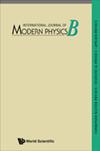Tuning the electronic structure and absorption spectrum of ZnTe/ZnS heterojunctions by selective doping with yttrium: A first-principle study
IF 2.8
4区 物理与天体物理
Q2 PHYSICS, APPLIED
引用次数: 0
Abstract
This paper systematically investigates the electronic structure and optical properties of zinc-blende ZnTe, ZnS systems, ZnTe/ZnS heterojunctions, and Y-doped ZnTe/ZnS heterostructions using the generalized gradient approximation (GGA) method under the density functional theory (DFT) framework. The results show that compared to the single-component ZnTe or ZnS systems, the ZnTe/ZnS heterojunction has a smaller bandgap width and undergoes a redshift in the absorption spectrum, which is favorable for more valence band electrons to be excited by light and transition to the conduction band, thereby enhancing the optoelectronic properties of the material. After Y-doping in the ZnTe/ZnS heterojunction system, when the doping concentration is between 1.56[Formula: see text]at% and 4.69[Formula: see text]at%, doping Y in the ZnS layer would result in the lowest energy formation of the system. Therefore, it can be inferred that in experiments, if the doping concentration is increased beyond this range, Y atoms are more likely to be arranged in the ZnS layer. Compared with the pure ZnTe/ZnS heterojunction system, increasing the Y doping concentration results in a wider bandgap and a more prominent blue shift in the absorption spectrum. Therefore, it is possible to adjust the bandgap of the heterojunction by changing the doping concentration to fabricate heterojunction device with different photoelectric effects and luminescence properties.选择性掺杂钇调谐ZnTe/ZnS异质结的电子结构和吸收光谱:第一性原理研究
本文采用密度泛函理论(DFT)框架下的广义梯度近似(GGA)方法系统地研究了锌掺杂ZnTe、ZnS体系、ZnTe/ZnS异质结和y掺杂ZnTe/ZnS异质结构的电子结构和光学性质。结果表明,与单组分ZnTe或ZnS体系相比,ZnTe/ZnS异质结的带隙宽度更小,吸收光谱发生红移,有利于更多的价带电子被光激发跃迁到导带,从而提高了材料的光电性能。在ZnTe/ZnS异质结体系中掺杂Y后,当掺杂浓度为1.56[公式:见文]%和4.69[公式:见文]%之间时,在ZnS层中掺杂Y会导致体系的能量生成最低。因此,可以推断,在实验中,如果掺杂浓度超过这个范围,Y原子更有可能排列在ZnS层中。与纯ZnTe/ZnS异质结体系相比,Y掺杂浓度的增加导致了更宽的带隙和更突出的吸收光谱蓝移。因此,可以通过改变掺杂浓度来调节异质结的带隙,从而制作出具有不同光电效应和发光性能的异质结器件。
本文章由计算机程序翻译,如有差异,请以英文原文为准。
求助全文
约1分钟内获得全文
求助全文
来源期刊

International Journal of Modern Physics B
物理-物理:凝聚态物理
CiteScore
3.70
自引率
11.80%
发文量
417
审稿时长
3.1 months
期刊介绍:
Launched in 1987, the International Journal of Modern Physics B covers the most important aspects and the latest developments in Condensed Matter Physics, Statistical Physics, as well as Atomic, Molecular and Optical Physics. A strong emphasis is placed on topics of current interest, such as cold atoms and molecules, new topological materials and phases, and novel low dimensional materials. One unique feature of this journal is its review section which contains articles with permanent research value besides the state-of-the-art research work in the relevant subject areas.
 求助内容:
求助内容: 应助结果提醒方式:
应助结果提醒方式:


